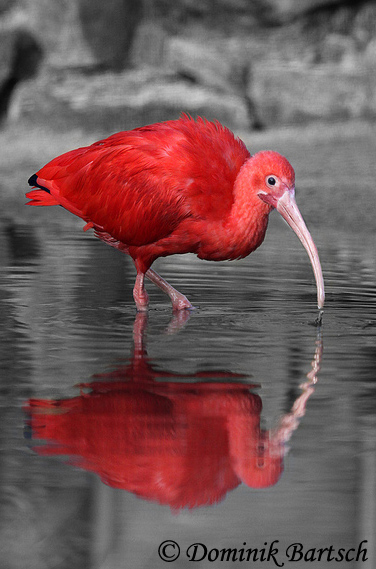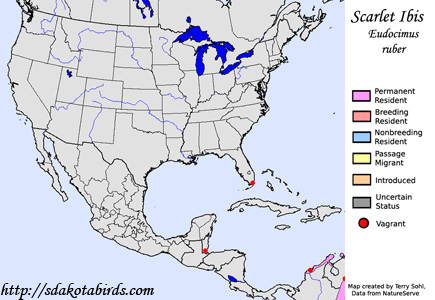| Length: 25 inches | Wingspan: 38 inches | Seasonality: Non-resident in South Dakota |
| ID Keys: Brilliant scarlet plumage, long decurved bill | ||
 The
Scarlet Ibis is an unmistakable sight in parts of Latin America, with its
brilliant red plumage making the species very easy to identify.
They are primarily found in coastal locations and along larger water and
wetland areas of northeastern South America. Their status in the
United States is somewhat questionable. Vagrants have been spotted
frequently in southern Florida, and have also on occasion been sighted
elsewhere in the U.S. Given the popularity of the bird as a zoo
specimen, it is likely that the rare sightings in most parts of the U.S. are
of escapees. However, it is quite likely that some of the birds
that have been found in south Florida are naturally occurring birds,
especially since some of the birds have been sighted after strong storm
systems move through the region.
The
Scarlet Ibis is an unmistakable sight in parts of Latin America, with its
brilliant red plumage making the species very easy to identify.
They are primarily found in coastal locations and along larger water and
wetland areas of northeastern South America. Their status in the
United States is somewhat questionable. Vagrants have been spotted
frequently in southern Florida, and have also on occasion been sighted
elsewhere in the U.S. Given the popularity of the bird as a zoo
specimen, it is likely that the rare sightings in most parts of the U.S. are
of escapees. However, it is quite likely that some of the birds
that have been found in south Florida are naturally occurring birds,
especially since some of the birds have been sighted after strong storm
systems move through the region.
Habitat: Can be found in a variety of aquatic habitats, including mangrove flats, inland lakes and rivers, and open marshland.
Diet: Feeds heavily on insects and small crustaceans, but will also take small fish, frogs and other amphibians, small lizards and snakes, and some plant material.
Behavior: Feeds by wading in shallow and using its long bill to probe in the mud or in the vegetation.
Nesting: They build nests of loose platforms of sticks and branches, typically in a mangrove or other forested wetland location. Nesting is usually done colonially. Both the male and female will share responsibilities in incubating the eggs and tending to the young.
Migration: Considered a permanent residen on much of its coastal range, but movements of birds in response to drought or other local driving forces result in relatively short-distance movements between coastal and inland locations.
Interactive eBird map: Click here to access an interactive eBird map of Scarlet Ibis sightings
Similar Species: Distinctive
Conservation Status: Listed as a species of "Least Concern" by the IUCN. The species has a wide geographic distribution and appears to be doing well.
Further Information: 1) Cornell's Neotropical Birds - Scarlet Ibis
2) WhoZoo.com - Scarlet Ibis
3) Wild Animals Online - Scarlet Ibis
Photo Information: Photo taken by Dominik Bartsch - Licensed under Creative Commons Attribution-Share-Alike 2.0 Generic License.
| Click below for a higher-resolution map |
 |
| South Dakota Status: Non-resident in South Dakota |
Additional Scarlet Ibis Photos (coming soon!!)
